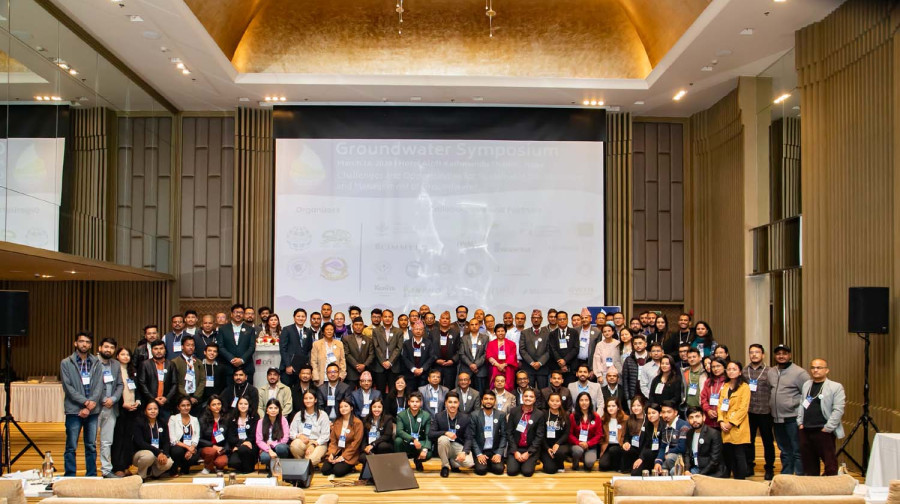National
Experts stress coherent institutional, policy framework for prudent groundwater use
Participants stress a multi-dimensional approach to address groundwater challenges.
Post Report
Participants of an international symposium have stressed a coherent institutional and policy framework for better management of groundwater in Nepal.
They underscored the need for stakeholder engagement, inter-governmental coordination and involvement of communities in decision-making processes to ensure sustainable groundwater management practices.
With increased water demand, groundwater resources are being excessively extracted, thereby raising concerns for its sustainable management, read a statement issued by the organisers after the conclusion of the event.
The 12th Groundwater Symposium organised at the Hotel Aloft, Thamel concluded on Monday.
The event was organised by the Centre of Research for Environment, Energy and Water (CREEW), the Small Earth Nepal (SEN), and the Kathmandu Valley Water Supply Management Board (KVSWMB), in association with 22 national and international partners and collaborators.
Kriangsak Pirarai, director of the Bureau of Groundwater Exploration and Potential Assessment, Department of Groundwater Resources, Thailand, highlighted the importance of proper regulation, conservation measures, and innovative approaches in groundwater management.
Engineer Sushil Chandra Tiwari, secretary for water resources and irrigation at the Ministry of Energy, Water Resources and Irrigation, shed light on the government’s emerging policies and plans for groundwater sustainability.
The symposium documented the scientific knowledge in different aspects of groundwater both from the national and regional level, which is believed to be helpful to the government organisations to develop implementable groundwater development and management plans, said Dhundi Raj Pathak, president of CREEW.
The sessions delved into critical topics such as enhancing groundwater governance in Southeast Asia and comprehending Nepal’s socio-hydrologies of groundwater irrigation. A dedicated technical session also spotlighted innovative approaches to tackle groundwater challenges, leveraging science, community engagement, and policy integration, read a statement issued by the organisers.
Presentations focused on the intersection of climate, agriculture, and groundwater resource management.
Churna Bahadur Wali, director general of the Department of Water Resources and Irrigation, said that Nepal’s Irrigation Plan 2018 has focused on conjunctive water resources used for irrigation and has the target to provide year-round irrigation.
Shanta Karki, deputy director general from the Department of Agriculture, shared that the Agricultural Act under formulation has prioritised sustainable use of groundwater, distribution and enhancing groundwater recharging capacity.
The high-level panel centred on the imperative of inclusive groundwater development and management in Nepal.
Panellists from academia, NGOs, and government bodies deliberated on strategies to surmount barriers and foster sustainable groundwater practices.
Manohara Khadka, country representative for IWMI Nepal, outlined six dimensions of inclusivity: multi-actor involvement, resource accessibility and capacity, investments, policy frameworks, knowledge management, and capacity development.
Tripti Rai, country director of Oxfam in Nepal, highlighted three primary factors contributing to exclusions: geographical disparities; caste and ethnicity; and gender and disability.
“Resources are always linked to power,” Rai said. “As long as we don’t understand how decisions are made, prioritised, and translated into political commitments, barriers will persist.”
According to the statement, the discussion underscored the necessity of integrating inclusivity considerations from the project’s outset rather than as an afterthought.
“This entails a thorough understanding of existing resources, such as hydrogeology and groundwater accounting, to inform project design effectively,” it said.
“The adoption of citizen science approaches was advocated to minimise resource-intensive investments while leveraging indigenous knowledge effectively.”
Also, participants recommended community-centric designs to ensure community ownership throughout the project lifecycle, which involves incorporating resilient infrastructure and empowering communities in both the design and monitoring phases.
This 12th edition of the groundwater symposium expanded its scope to include regional and international perspectives and created a cross-learning platform attracting approximately 200 participants, with 150 attending in person and 50 virtually.




 10.12°C Kathmandu
10.12°C Kathmandu














